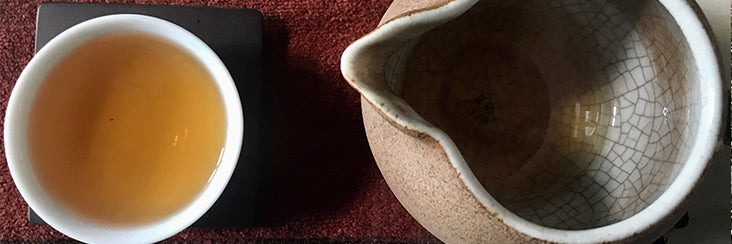
Dong Ding Tie Guan Yin Tasting Notes | Eco-Cha Tea Club

This month's batch of tea being shared with the Eco-Cha Tea Club was made by Mr. Su — an 80 year-old artisan of traditional Dong Ding Oolong Tea. He planted a plot of the Tie Guan Yin strain in his backyard several years ago, and this is the second time we've sourced this tea type from him. Mr. Su is our favorite representative of traditionally made tea in Taiwan, and it brings us a special kind of joy to be able to share his tea with our tea club members.
This batch has a particularly sweet character, with slightly tangy, fruity notes and a pleasantly clean lingering aftertaste. It has just enough of that cured, almost fermented character that makes it reminiscent of a traditionally made Tie Guan Yin Oolong. But given that it was only roasted once, it maintains a mild flavor profile similar to a Hong Shui Oolong.

The first batch of this tea type that we shared with the Eco-Cha Tea Club two years ago was very similar to Dong Ding Oolong Tea made in the contemporary fashion. The oxidation, rolling and roasting methods were about the same as a quality Dong Ding Oolong we find being made by local artisans today. This month's batch is distinctly more representative of a traditional Oolong in that the leaves are more oxidized, loosely rolled, and only mildly roasted.

In this sense, it is similar to the locally made tea before Dong Ding Oolong tea was standardized and promoted commercially some 30 years ago. This type of tea made by pre-modern methods is now referred to as Hong Shui Oolong. The differences between Dong Ding and Hong Shui are in the degree of oxidation and roasting. Hong Shui tea leaves are oxidized about twice as much as Dong Ding, and are typically not roasted, or only very slightly.

Modern tea making methods have developed a standard of rolling the leaves very tightly for the purposes of preventing crumbling, efficient packaging, and preserving freshness. Before the invention of machines to do this work, it was done by hand (and foot!). The pre-modern rolling method also had an asset that complemented the traditional way of making tea. Loosely rolled leaves are more conducive to post-production oxidation and aging. The traditional recipe of extensive oxidation and sufficient drying/light roasting of the leaves provided proper curing of the tea to stabilize the character and preserve freshness. By storing the leaves in a cool, dry place, out of direct light, they only get better with age. This is the inherent wisdom in traditionally made tea.

We look forward to hearing about your experience of this month's batch of tea being shared with the Eco-Cha Tea Club. Please post your comments, photos, and tasting videos here for all of us to see and learn from! See you next month, when we will be getting ready to Chinese New Year — the Year of the Earth Dog!

